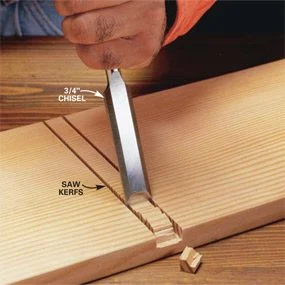
Using a wood chisel properly requires good technique and attention to safety. Here’s a step-by-step guide on how to use a wood chisel effectively:
Select the Right Chisel:
Choose the appropriate chisel for your specific task. Consider factors such as the type of cut, wood hardness, and desired level of precision. Bench chisels are a good starting point for general woodworking tasks.
Prepare the Workpiece:
Secure the workpiece firmly in a vise or clamp to prevent movement while you’re working. This ensures stability and safe chiseling.
Mark the Cutting Line:
Use a pencil or marking knife to mark the specific area where you want to cut or shape the wood. This provides a visual guide for accurate chiseling.
Grip the Chisel:
Hold the chisel with a firm grip, placing your dominant hand on the handle and your other hand closer to the blade for better control and guidance.
Position the Chisel:
Align the cutting edge of the chisel with the marked cutting line on the workpiece. Ensure that the beveled side of the chisel faces towards the waste material that you intend to remove.
Start with Light Strikes:
Using a mallet or hammer, begin tapping the chisel gently with controlled and light strikes. This helps establish the initial cut and prevents the chisel from slipping or digging too deeply.
Gradually Increase Force:
As you progress and establish a deeper cut, you can increase the force of your strikes. Be mindful not to strike too hard, as it can damage the wood or cause the chisel to slip.
Maintain Control and Accuracy:
Throughout the process, maintain control over the chisel, guiding it along the cutting line with deliberate and controlled movements. Take your time, especially when working on intricate or delicate areas.
Use Bevel Techniques:
Depending on the task, you can employ different chiseling techniques. For general cutting or shaping, use the bevel-down technique where the entire beveled cutting edge contacts the wood. For more delicate work or paring cuts, the bevel-up technique can be used, where only a small portion of the chisel’s bevel touches the wood.
Test and Refine:
Periodically test the progress of your cut or shaping by checking against your desired outcome. Make adjustments and refine the work as needed, ensuring that you achieve the desired result.
Practice Safety:
Always wear safety goggles or glasses to protect your eyes from flying wood chips. Maintain control over the chisel and be aware of your fingers’ position in relation to the cutting edge to prevent accidental slips or cuts.
Finishing Touches:
Once you’ve completed the desired cuts or shaping, use sandpaper or other appropriate tools to smooth and refine the surface as needed.
Remember to practice and develop your chiseling skills over time. With experience, you’ll become more proficient in controlling the chisel and achieving the desired results in your woodworking projects.